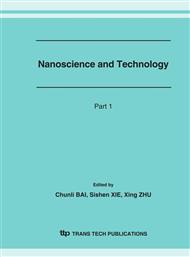p.1363
p.1367
p.1371
p.1375
p.1379
p.1387
p.1391
p.1395
p.1399
Nanoelectrode-Gated Detection of Individual Molecules with Potential for Rapid DNA Sequencing
Abstract:
A systematic nanoelectrode-gated electron-tunneling molecular-detection concept with potential for rapid DNA sequencing has recently been invented at Oak Ridge National Laboratory (ORNL). A DNA molecule is a polymer that typically contains four different types of nucleotide bases: adenine (A), thymine (T), guanine (G), and cytosine (C) on its phosphate-deoxyribose chain. According to the nanoelectrode-gated molecular-detection concept, it should be possible to obtain genetic sequence information by probing through a DNA molecule base by base at a nanometer scale, as if looking at a strip of movie film. The nanoscale reading of DNA sequences is envisioned to take place at a nanogap (gate) defined by a pair of nanoelectrode tips as a DNA molecule moves through the gate base by base. The rationale is that sample molecules, such as the four different nucleotide bases, each with a distinct chemical composition and structure, should produce a specific perturbation effect on the tunneling electron beam across the two nanoelectrode tips. A sample molecule could thus be detected when it enters the gate. This nanoscience-based approach could lead to a new DNA sequencing technology that could be thousands of times faster than the current technology (Sanger’s “dideoxy” protocol-based capillary electrophoresis systems). Both computational and experimental studies are underway at ORNL towards demonstrating this nanotechnology concept.
Info:
Periodical:
Pages:
1379-1386
Citation:
Online since:
March 2007
Authors:
Price:
Сopyright:
© 2007 Trans Tech Publications Ltd. All Rights Reserved
Share:
Citation:


